Killer Kebari
The Killer Kebari is the fly I tied for the first tenkara fly swap held in the US, which requested each participant's best tenkara fly. I had created the pattern in 2011 by adding a sparse soft hackle to Sawyer's Killer Bug. The hackle is taken from the neck of a hen pheasant. Unfortunately, many hen pheasant skins do not include the neck, so the proper feather can be pretty hard to find.
I have tied the fly with partridge, but the hackle isn't quite the same. I would suggest continuing to look for a hen pheasant skin that has the neck attached.
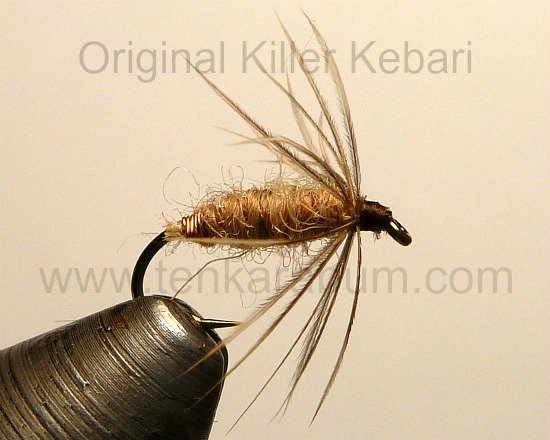 The Original Killer Kebari
The Original Killer KebariI have now seen photos and even "how to" videos that purport to show a Killer Kebari. Many are so far off that they should carry a different name. I do not believe in trademarking fly names, so I have no recourse other than to suggest that if you can't trust the website on that, perhaps you cannot trust them on other things as well. A Killer Kebari, first and foremost, is NOT a sakasa kebari! The hackle is very sparse and tied in the "jun" style (hackle slanting back towards the hook bend). The worst offender, by far, is a video still on YouTube, in which the is tied with an extreme forward slanting hackle. What's more, the tyer maintained that it is a fly he tied back in the '70s. He must be a time traveler because the pattern was developed and named in 2011.
Most American anglers, when they think of tenkara flies, probably think of the reverse hackled sakasa kebari. However, the excellent work that Yoshikazu Fujioka has done in cataloging the various tenkara patterns (Tenkara Fly Patterns), indicates that not all tenkara fly patterns used in Japan have reversed hackles.
One of the Hida Takayama flies is just a fairly thick wool body with a soft hackle of hen or hen pheasant.
Although the Hida Takayama pattern calls for black yarn and black hackle, a soft hackled, yarn bodied fly is about the perfect description of what you would get if you added a soft hackle to a killer bug. The standard killer bug is very effective as is, but before I even learned of the Hida Takayama pattern, I had been fishing hackled killer bugs and doing well with them.
There is a lot to be said for fishing a hackled fly - particularly when fishing a tenkara rod. One of the central themes of tenkara fishing is that the presentation is more important than the fly choice, and a hackled fly can give you just a little bit more flexibility with respect to presentation.
A scud or nymph imitation can be fished dead drift, pulsed to mimic the swimming action of a scud, or manipulated with a Leisenring lift or other induced take method to mimic a mayfly nymph or caddis pupa rising to the surface to hatch. With a bit of soft hackle, though, pulsing the fly causes the hackle to open and closes and give additional evidence of life. Also, a hackled fly kept on or near the surface can also mimic an emerger.
With its fat body and sparse soft hackle, the Killer Kebari looks a lot like a caddis pupa. We'll never know what the fish think it looks like - but evidently they do think it looks like food.
I once saw a slide presentation on soft hackles given by a well known figure in fly fishing and fly tying circles. One of his slides was an illustration of what he called a common mistake - making the body too fat. It looked just like my Killer Kebari! I am sure he was thinking of the thin bodied, ultra sparse North Country spiders. I didn't have the heart to tell him that his "mistake" catches fish like crazy!
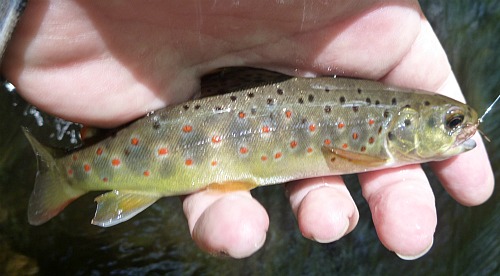
Killer Kebari Step by Step
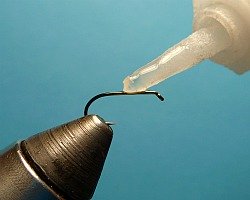
1. I generally use a Daiichi 1550, size 14 hook. Because copper wire wrapped around a bare hook shank will slip pretty
easily, put a drop of super glue on the hook shank. I find a brush
applicator works a little better but the more common tube applicator
works.
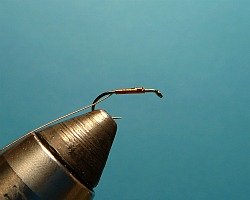
2. Start wrapping the wire a little further back from where you'll want the hackle to be - maybe a third of the way down the shank. Wrap in touching turns towards the bend, stopping opposite a point about halfway between the hook point and the barb.
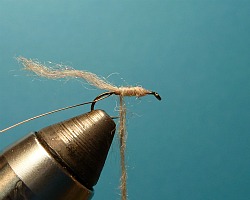
3. The yarn I use is Jamieson's Shetland Spindrift (the color is Sand #183), which is a two-ply yarn. This fly is a bit small to use both plies, so separate the two plies and just use one. I generally cut a couple feet at a time to separate. Start the yarn (just like you would tying thread) just behind where the hackle will go. After about 5 tight wraps, cut off the tag end. The photo shows just before it was cut.
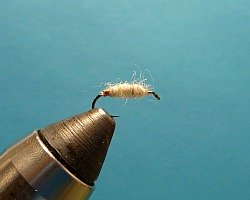
4. Wrap the yarn fairly tightly in touching turns to a little before the bend of the hook, then back to your starting point and back again to just past where you stopped wrapping the first layer. Trap the yarn with one turn of the copper wire, then do a 4 turn whip finish with the copper wire, with each wrap of the whip finish in front of the previous one. Break off the copper wire and cut the tag end of the yarn.
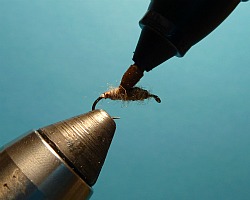
5. Color the yarn lightly with a Sand (#70) Prismacolor marker. At first, the yarn will look too dark, but the color sinks in and also fades a bit after your first cast. When wet, the fly will have nice pinkish tan hue. After you've colored the yarn, you could touch the copper wraps with head cement although I don't and I've never had one come apart.
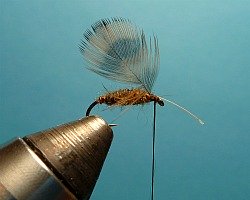
6. Start the thread just behind the eye, wrap back to the yarn and tie in a small feather from a hen pheasant neck. Make just one
wrap of hackle. Given the shape of the feather, I prefer tying in the feather by the stem.
7. Tie off the hackle, trim, form a neat head and whip finish. I use a
dark brown thread, which complements the body color nicely. Tan would work also.
The same fly can be tied with a black or charcoal gray yarn, a starling feather and black thread. That makes it a different pattern, one I call a Little Dark Kebari.

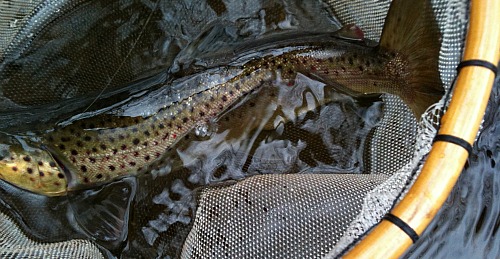
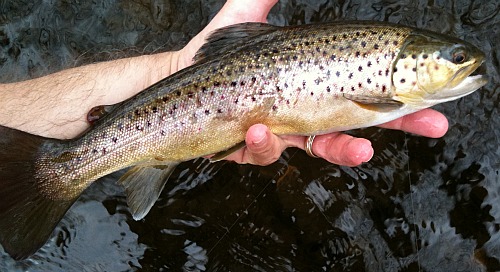
TenkaraBum Home > Tenkara Flies > Killer Kebari
“The bitterness of poor quality remains long after the sweetness of low price is forgotten” - Benjamin Franklin
"Be sure in casting, that your fly fall first into the water, for if the line fall first, it scares or frightens the fish..." -
Col. Robert Venables 1662
As age slows my pace, I will become more like the heron.
Warning:
The hooks are sharp.
The coffee's hot.
The fish are slippery when wet.
Beware of the Dogma
Currently processing orders that were received Mar 8.
This Just In
Thanks for the Killer Bugs but the real winner in Yosemite backcountry was the Killer Kebari you sent. They could not resist it! I will be getting more of those. Unfortunately I lost it in a tree but not before feeding it to quite a few fish. Thanks again!
John W, California
Your Killer Kebari pattern was deadly on the North Carolina Nantahala yesterday. Water 40 degrees and after one day of bamboo rod and streamer with 2 fish, my Iwana and your pattern caught over 13 fish - in dead winter the next day. Just sent 2nd order!
William H, Georgia


